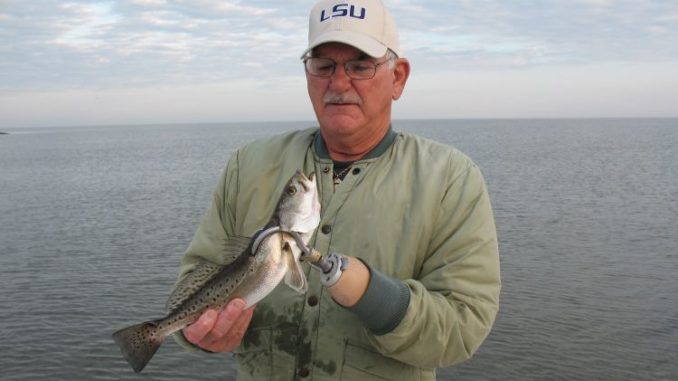
Warmer temps send trout to rigs in deeper waters of the Sound
According to Tim “Capt. Hook” Ursin (504-512-2602) down in Shell Beach, once the air temperatures start reaching the high 80’s and low 90’s, the trout start moving into Breton Sound and into deeper water.
“It’s the normal, annual migration,” he said. “We’ve been catching trout in the big fringe bays, over reefs and around points through May, and of course, along the MRGO Rocks. You’ll still be able to catch fish in those areas until the weather gets hot. Then it slows down and you have to move deeper into the Bay Eloi waters and fish rigs and wells, and then into the Sound itself and rig hop until you find them.”
Hook said live shrimp is pretty much a necessity, and also live croakers at the deeper wells and platforms.
“There’s a few ways to fish the deeper areas,” he said. “I usually start out under a cork, maybe 3 or 4 feet deep, with a split-shot or two on my leader to keep the bait down. On days with harder current movement I’ll still fish under a cork, but a little deeper, like 5 foot, and with two or more heavier split-shot sinkers to keep my bait from floating up in the current. If I get hits on the 5-foot bait, I’ll try even deeper, switching to either a bottom rig or a sliding cork rig, both of which are more challenging to fish. The bottom rigs snag up so quickly out there because the bottom is littered with debris. Be prepared to re-tie a whole lot of lines if you fish bottom. The sliding cork rigs can be effective because they keep the bait off the debris on the bottom, but they are harder to get the hang of. People want to “pop” them like they do a popping cork, but that really doesn’t work with a sliding cork because it won’t pop. You can pull it up slowly and let it fall, but that’s all. Then you always have issues with the stop knots slipping, so you wind up again, having to spend more time fiddling with the tackle than catching fish. However, when the fish are there, it’s worth all the hassle because those outside trout tend to average two pounds each with even bigger ones in the mix.
“Then, on your way back in, stop in Lake Robin or Lake Coquille and soak a shrimp about 18 inches under a cork up near a point, a marsh island or a cut, and see if you can add a few redfish to the box.”
